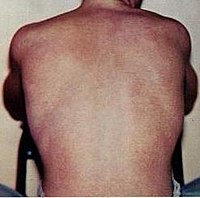
Photo from wikipedia
Monkeypox is a zoonotic disease, endemic in central and west African regions, and has re‐emerged, currently causing an outbreak as of May 2022. In this systematic review, we aimed to… Click to show full abstract
Monkeypox is a zoonotic disease, endemic in central and west African regions, and has re‐emerged, currently causing an outbreak as of May 2022. In this systematic review, we aimed to characterize the current face of the disease, with a detailed categorization of mucocutaneous, as well as systemic symptoms of the disease. We searched four main online databases with the keywords “monkeypox” and “Orthopoxvirus”. A total of 46 articles were included, with a cumulative number of 1984 confirmed cases. Patients were predominantly men who have sex with men, who were mostly in their 30s, with a history of unprotected sexual contact or international travel. Among mucocutaneous manifestations, anogenital lesions were the most commonly observed, followed by lesions on the limbs, face, trunk, and palms or soles. Among lesion types, vesiculopustular, pustular or pseudo‐pustular, vesicular‐umbilicated and papular lesions were the most common, mainly presenting asynchronously, with less than 10 lesions on each patient. Almost all patients also reported systemic manifestations, namely fever, lymphadenopathy, fatigue, myalgia, headaches, pharyngitis, and proctitis. Sexual contact is the main pathway of transmission in the current outbreak, with viral shedding in bodily fluids playing a key role. We've compared these idiosyncratic findings of the new outbreak with previous outbreaks. We've also gathered and categorized images from our included studies to make a “clinical atlas” for this “new” face of monkeypox, which can be of utmost importance for clinicians to be familiarized with, and have a clear picture of monkeypox for their differential diagnoses.
Journal Title: Journal of Medical Virology
Year Published: 2022
Link to full text (if available)
Share on Social Media: Sign Up to like & get
recommendations!